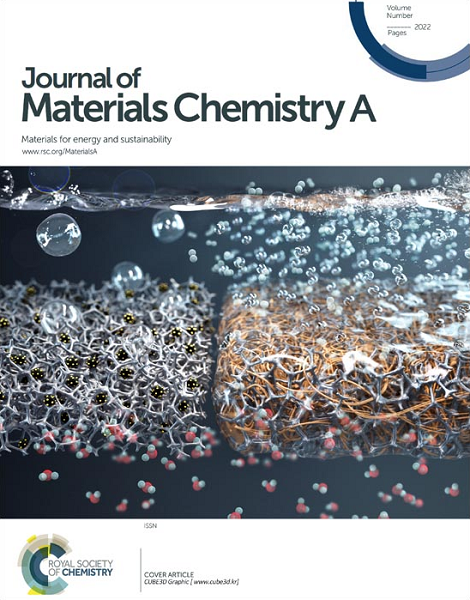甲酸通过K+插层氮化碳光放大制氢和C(sp2)-N交叉偶联:燃料和高端医药可持续发展的新前景
IF 10.7
2区 材料科学
Q1 CHEMISTRY, PHYSICAL
引用次数: 0
摘要
太阳能推进液体有机氢(H2)载体甲酸(FA)脱氢是一种很有前途的绿色制氢途径。在这方面,我们已经证明了插入钾(K+)氮化碳(KPCN)作为光催化剂,释放了一条新的途径,即FA作为C1源与邻苯二胺(PDA)的光氧化还原交叉偶联协同作用,使FA光价化为H2,从而产生苯并咪唑(BA)。Pt/1KPCN产生94µmol.h-1。H2的g-1比裸Pt/CN高23倍,并且在λ = 400 nm处,PDA的转化率为50%,生成具有重要药理意义的BA, AQY为0.93%。此外,通过PL、光电流和固态EPR研究确定了K+掺入Pt/1KPCN后的电荷转移动力学。此外,通过清道夫控制实验和CO2 TPD分析,对包括碱度在内的合理机理进行了深入探讨。显然,Pt/1KPCN已经显示出进一步将原位生成的CO2分子(通过脱氢)还原为CO分子的潜力。因此,目前的工作提供了一种新的更温和的可持续方案,以加速FA作为可再生能源的发展,不仅可以生产合成气(一种用于费托合成(FTS)的太阳能燃料前体),还可以通过生产高端药物来培育碳循环经济。本文章由计算机程序翻译,如有差异,请以英文原文为准。
Photo Upscaling of Formic Acid to H2 and C(sp2)-N Cross-Coupling via K+ Intercalated Carbon Nitride: A New Sustainable Horizon Towards Fuel and High-end Pharmaceutics
Solar propelled liquid organic hydrogen (H2) bearer - formic acid (FA) dehydrogenation is one of the promising pathway for green H2 production. In this regard, we have shown potassium intercalated (K+) carbon nitride (KPCN) as photocatalyst to unleash a new route, photo-valorization of FA to H2 in synergism with photo-redox cross-coupling of FA as C1 source with o-phenylenediamine (PDA) to produce benzimidazole (BA). It was realized that Pt/1KPCN produces 94 µmol.h-1.g-1 of H2 which was 23-folds higher compared to bare Pt/CN along with 50 % conversion of PDA to produce pharmaceutically important BA with AQY of 0.93 % at λ = 400 nm. Besides, charge transfer kinetics of Pt/1KPCN after K+ incorporation was ascertained by PL, photocurrent and solid-state EPR studies. Further the plausible mechanistic insights including basicity were thoroughly probed by scavenger-controlled experiments and CO2 TPD analysis, respectively. Apparently, Pt/1KPCN has shown the potential further to reduce in situ generated CO2 molecules (via dehydrogenation) to CO molecules. Thus, the current work provides a new milder sustainable protocol to expedite FA as renewable source not only to produce syngas, a solar fuel precursor for the Fischer-Tropsch synthesis (FTS) but also to nurture the carbon circular economy by producing high-end pharmaceutics.
求助全文
通过发布文献求助,成功后即可免费获取论文全文。
去求助
来源期刊

Journal of Materials Chemistry A
CHEMISTRY, PHYSICAL-ENERGY & FUELS
CiteScore
19.50
自引率
5.00%
发文量
1892
审稿时长
1.5 months
期刊介绍:
The Journal of Materials Chemistry A, B & C covers a wide range of high-quality studies in the field of materials chemistry, with each section focusing on specific applications of the materials studied. Journal of Materials Chemistry A emphasizes applications in energy and sustainability, including topics such as artificial photosynthesis, batteries, and fuel cells. Journal of Materials Chemistry B focuses on applications in biology and medicine, while Journal of Materials Chemistry C covers applications in optical, magnetic, and electronic devices. Example topic areas within the scope of Journal of Materials Chemistry A include catalysis, green/sustainable materials, sensors, and water treatment, among others.
 求助内容:
求助内容: 应助结果提醒方式:
应助结果提醒方式:


